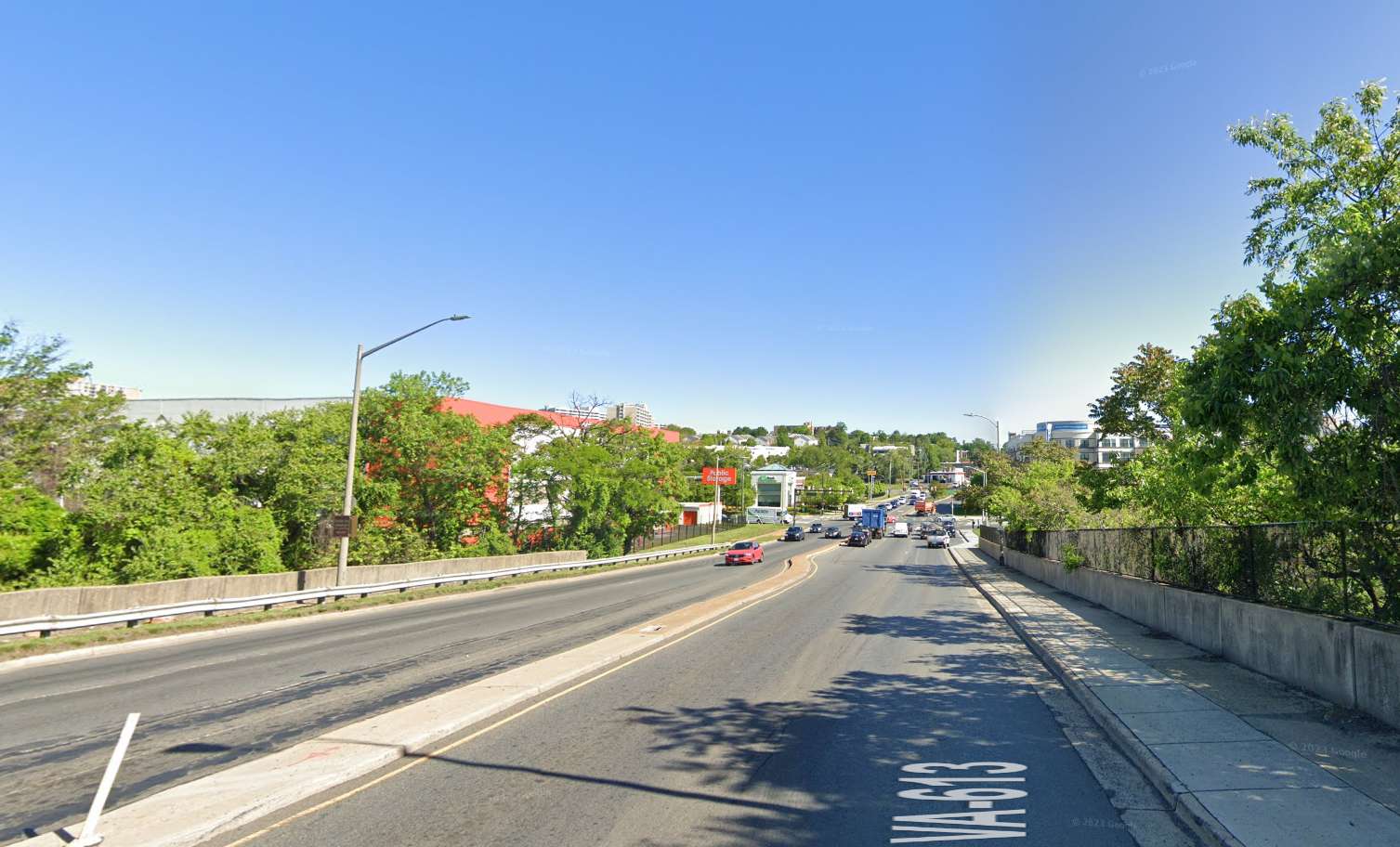
If Alexandria wants the transit corridors it dreams of, Planning Commission Chair Nathan Macek said it’s going to need to do more to secure federal funding.
In a budget discussion at the Planning Commission meeting last week, Macek noted that there is “no plan to pursue federal money” for two of the major transit corridors in the city budget.
Transitway corridors are areas where the city is hoping to implement “enhanced transit services” like bus rapid transit, a streetcar, dedicated bus lanes and more. Corridor B is the Duke Street / Eisenhower Avenue corridor. Corridor C is the Van Dorn Street / Beauregard Street corridor.
Macek said in the meeting that the funding set aside for transit development on those corridors is all local and regional funding.
“I will make, at every call, every opportunity I have, the call that we should be pursuing federal money for these projects,” Macek said.
Macek said he has concerns that the city is missing out on a chance to make those transit on those corridors better.
“My concern with the way we’re deploying BRT is we’re so content to make it happen with local and regional, and we’re not pursuing federal money that could help make this a real, functional, better bus rapid transit,” Macek said. “Totally missing that opportunity to pursue federal funds that could help us address the issues we have in these corridors.”
Staff told Macek at the meeting that one of the limits of the budget is it doesn’t show what avenues are being pursued, just what’s secure in the budget. Staff said efforts are underway to lock down federal funding for transit corridors.
Macek noted the Van Dorn Street Corridor in particular, which is seeing an upswing in new projects like the Vulcan property development, could benefit from federal funding for transit needs and possible widening.
“When we’re only working with local and regional money, we necessarily limit the scope of what we can accomplish because of that,” Macek said.
Photo via Google Maps
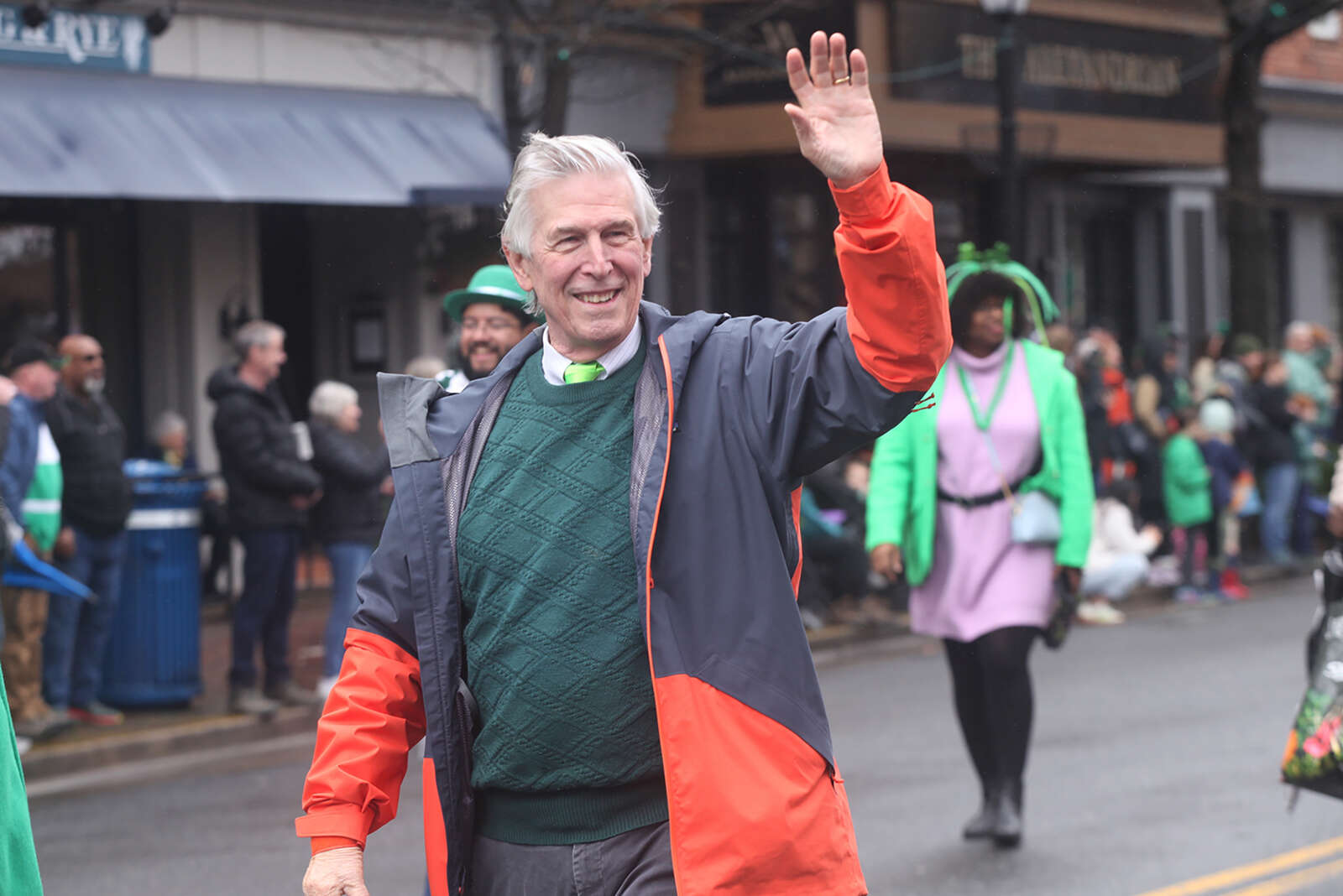
Alexandria is getting $3.5 million in federal funds to pay for public safety, transit, affordable housing and flooding infrastructure projects, Northern Virginia Congressman Don Beyer (D-8th) announced today.
“Even in the minority amid a divided and chaotic Congress, I am laser focused on helping my constituents and benefitting Northern Virginia,” Beyer said in a statement.
Beyer secured a total of $13 million federal funding in the 2024 Consolidated Appropriations Act, which the House of Representatives approved on Wednesday, to pay for 15 projects in Alexandria, Arlington and Fairfax County. The Senate is expected to approve the legislation next week, Beyer’s office said.
The Alexandria projects are:
$1 million for on-route electric transit bus opportunity chargers. The funding would be used to fund the construction and implementation of up to two on-route opportunity fast chargers within the City of Alexandria, which would support charging requirements of a full 100% Zero Emissions Battery Electric transit bus fleet. The chargers would be constructed in strategic locations throughout the City and the DASH bus network to help ensure that the future fleet of 100+ Zero Emissions transit buses can meet the demand of DASH’s 24/7 service, serving the community of Alexandria
$963,000 for the Virginia Tech “Smart Mobility Lab.” The funding would be used to establish Smart Mobility Lab (SML) operations and invest in initial research and technology development where gaps exist to attract and leverage industry engagement. The SML will be sustained in future years through publicly and privately sponsored research from industry and government partners. Some smart mobility technologies that may be deployed in the SML include: a data exchange system for integrating data from various systems deployed in the SML while providing security and appropriate access for research and development opportunities; smart intersection solutions that identify conflicts and improve vulnerable road users’ safety; adaptive lighting on roadways that adjust with changing weather conditions and traffic; implementation of customizable features (like real-time red light patterns changes) to accommodate traffic flow; and the analysis and creation of mobility hubs to connect multiple modes of transportation and make commuting easier.
$670,000 for a pilot program for crime and violence prevention. This supports funding enhanced technology, including In-Car Cameras, Fixed License Plate Readers (LPRs), and Surveillance Trailers, in the City of Alexandria. This funding will assist Alexandria’s law enforcement agency in its ongoing efforts to reduce incidents of violent crime and gun violence in the Alexandria community. The Alexandria Police Department will use these funds to invest in cutting-edge technology and equipment that will significantly enhance its ability to deter, respond, investigate, and successfully prosecute violent crimes.
$850,000 for the restoration of affordable housing at the 1022 Pendleton Street Boarding House. The project will allow the City of Alexandria to work with property owners to preserve unique, affordable housing in our community while renovating a building with historic, cultural and architectural significance. The boarding house currently includes 8 housing units with deeply affordable rents, as well as shared living space and room for the restoration of retail/commercial space original to the property.

The Alexandria School Board approved its fiscal year 2025 $384.4 million combined funds budget on Thursday night and it is asking City Council for $21 million more than the previous budget. If it goes forward, Mayor Justin Wilson says that the request could mean a reduction in city services.
School Board Members tacked on more than $10 million in additions to Superintendent Melanie Kay-Wyatt’s proposed budget, a move that prompted Board Members Meagan Alderton and Chris Harris to vote in opposition to it.
Alderton said that the budget is difficult for the Board to defend.
“For our add/delete session, the board essentially doubled the superintendent’s proposed increase, shifting our ask to an 8.1% city appropriation,” she said at the Board meeting. “City appropriations for the operating budget are not one-time asks when you’re asking for an additional appropriation in any fiscal year. You’re also asking for a promise that this level of funding can be sustained every fiscal year thereafter. So, an additional $10 million dollar promise is one thing, but the additional $21 million promise changes the game entirely.”
City Manager Jim Parajon’s draft FY 2025 budget will be unveiled next Tuesday.
Wilson said that he has not yet reviewed the ACPS budget, but said that the city must be clear about the details of this year’s budget process.
“The School Board’s recent budget decisions more than doubled the superintendent’s request for additional City appropriation, without any offsetting spending reductions in other areas of the budget,” Wilson said. “Funding that increase will require deep spending reductions to other critical services (public safety, human services, transportation or infrastructure), significant tax increases, or both. I look forward to dialogue with the School Board about the details of their request, and the options available for the two bodies as we begin our budget process next week.”
School Board Chair Michelle Rief said that the budget underscores the Board’s commitment to students and staff.
“This budget is a testament to our collective vision for growing a thriving educational community that supports staff and prepares our students for the future,” Rief said.
Wilson said that in the fall, City staff was projecting that Alexandria’s real estate tax base would increase 2.4%, which would have resulted in a $20 million budget shortfall if the School Board had approved what the Superintendent’s budget proposal included. But instead, the real estate tax base grew by 0.33%, the smallest rate of increase in 15 years.
“So, that gap of $20 million is in fact, much larger,” Wilson said.
Superintendent Melanie Kay-Wyatt thanked the Board for their approval, and said that her proposed budget focuses on retention, with a full step increase and a 2% market rate adjustment for eligible staff. The school system is experiencing a staffing crisis, and the budget increases bus driver salaries to $24 an hour for new drivers and more than $47 per hour for senior drivers with more than a decade experience with the school system.
“I truly value the collaboration between the division and the Alexandria City School Board, and would like to thank them for their approval of the FY 2025 Combined Funds budget,” Kay-Wyatt said in a statement. “I also want to express my appreciation for our dedicated Financial Services team for continuing to work to find innovative solutions to the complex budget challenges the division faces. Together we will continue to advocate and work to produce a budget that best supports our students and staff until it is fully adopted in the spring.”
City Council Member John Taylor Chapman said that he wants to see how the Board has prioritized its allocations.
“Conversation is key for our school system, and getting good teachers,” Chapman said. “Past School Boards have been able to turn in a budget that is able to compete with getting good school teachers, balancing priorities and understanding the greater stake in the city’s financial picture. I would assume that is happening this year as well.”
Additions to the budget include:
- $4.2 million for staffers who did not get step increases in fiscal year 2021 (sponsored by Member Abdel Elnoubi)
- $307,000 for two deans of students at George Washington and Francis C. Hammond Middle Schools (sponsored by Tammy Ignacio)
- $125,000 for a college and career counselor at ACHS (sponsored by Member Jacinta Greene)
- $125,000 for a psychologist at ACHS Minnie Howard Campus (sponsored by Member Abdel Elnoubi)
- $115,000 for an athletic trainer at ACHS (sponsored by Member Chris Harris)
- $65,000 for a Dari/Pashto/English fluent-speaking family liaison (sponsored by Harris)
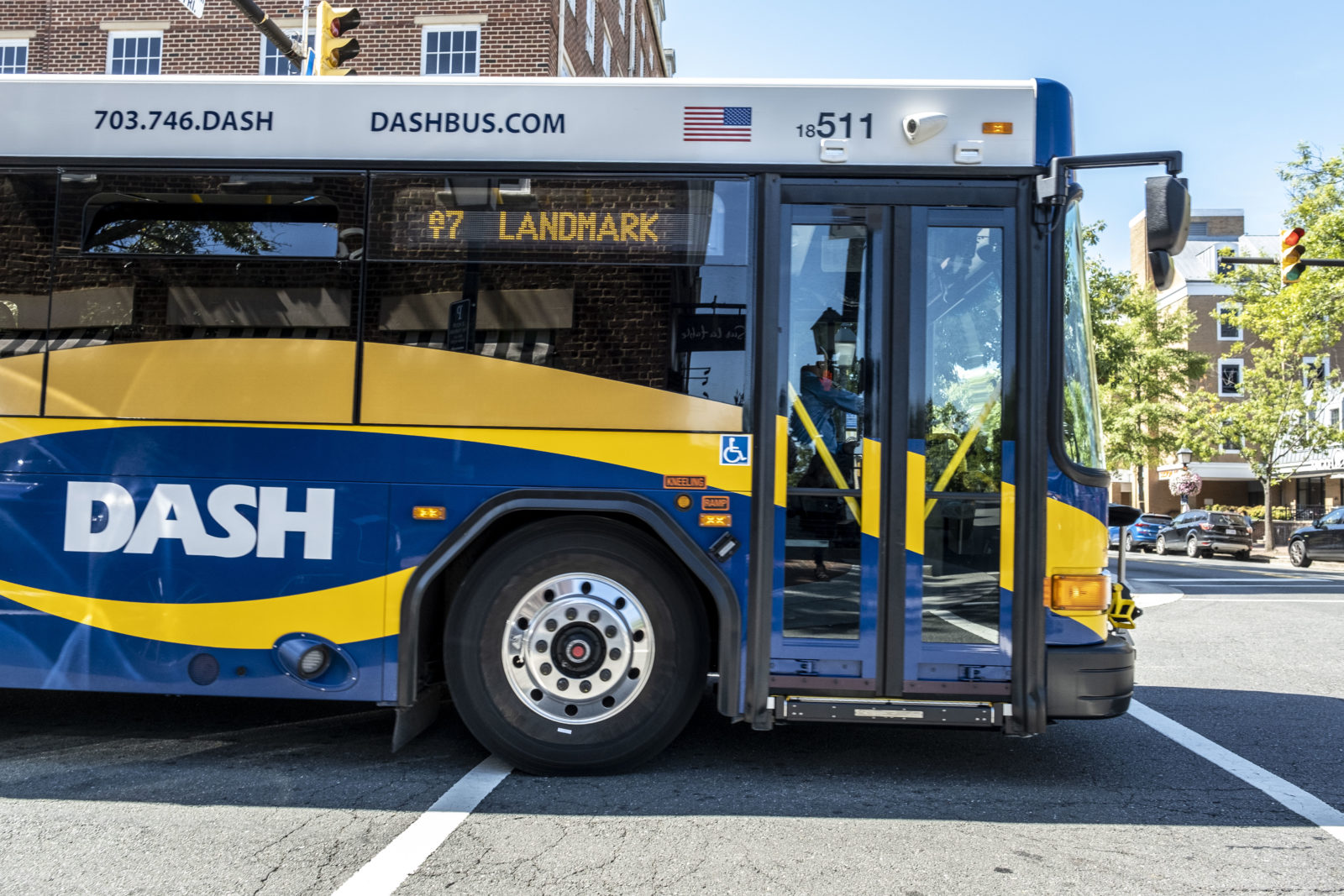
Alexandria’s DASH bus system is seeking state funding for a project to add new information screens inside the city’s buses.
A pilot program would install information screens that would help show things like upcoming stops, transfer connections, service alerts and more.
According to a grant application for $200,000:
This pilot would allow DASH to install two information screens onboard up to 10 buses that would display upcoming bus stops, transfer connections, service alerts, advertisements, and other customer outreach information. These infotainment screens would enhance overall accessibility and ease of use for DASH riders. DASH would be one of the first transit agencies in the state to install such screens on their buses and could install the screens on all buses going forward if the pilot is successful.
The project would require a 20% match from the city with an estimate that supporting the new screens would cost an additional $10,000-$15,000 annually.
Another $100,000 grant application would provide funding for new camera systems on buses to help bus operators see people or objects in blind spots created by the two front pillars on the bus.
“The screens would be mounted on the pillars to effectively remove these dangerous blind spots for bus operators,” the application said. “This could greatly improve bus and pedestrian safety and would promote ongoing Vision Zero objectives.”
The biggest application, though, is for $37 million request for operating assistance for rising labor and fuel costs. According to the application:
Operating assistance to jurisdictions is allocated based on system size and system performance for both DASH and DOT paratransit. Operating costs have increased over the past few years due to labor and fuel costs. The amount the Commonwealth can provide in operating assistance varies annually but has typically been between 20% and 30%.
The grant applications are scheduled for review at a City Council meeting on Tuesday, Jan. 23.
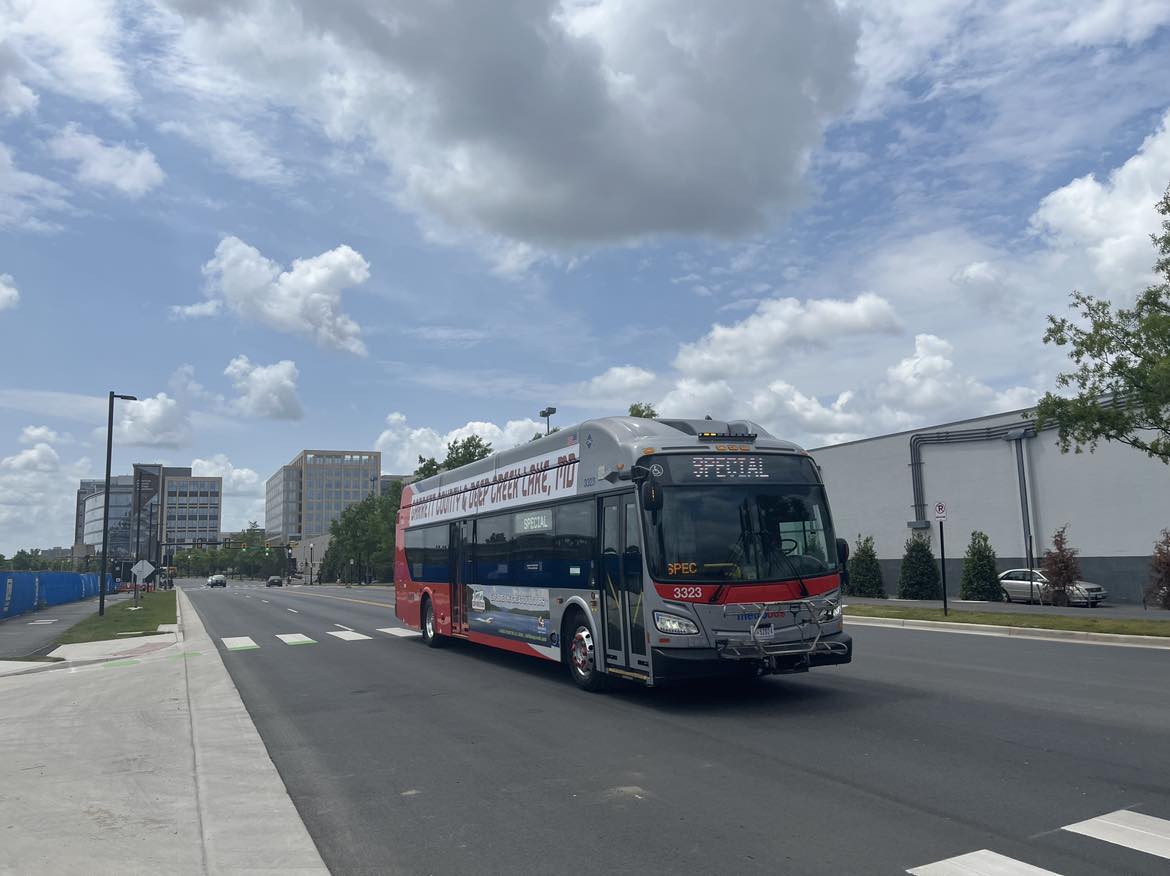
If Metrobus service is cut back, as WMATA has threatened, several Alexandria lines could be on the chopping block.
General Manager Randy Clarke warned that bus service cuts and job cuts are imminent if the transit agency doesn’t close its $750 million budget gap, adding that he said it’s time for a regional tax to permanently fund WMATA.
Under the drastic cuts proposed by Clarke, all stations would close at 10 p.m., train frequency would drop, and ten stations would be shut down. Among the stations being considered for a shutdown is Alexandria’s new Potomac Yard station, which is also the centerpiece of transit plans for the new Monumental arena.
Clarke also released a list of bus routes, nearly half the Metrobus lines, that would be cut or have reduced service. Many of those routes in Alexandria go through the West End to connect to the Pentagon
The Metrobus lines in Alexandria that would be cut include:
- Route 8W runs through the West End to the Pentagon
- Routes 17B, 17G, 17K and 17M, also running through West End to the Pentagon
- Routes 18G, 18J, 18P, which go through Springfield, up into Alexandria’s West End, and finish at the Pentagon
- Route 21C from Landmark to the Pentagon
- Route 22A through Parkfairfax and the Bradlee Shopping Center up to the Pentagon
- Route 22F from Northern Virginia Community College up to the Pentagon
- Route 28F from S. George Mason Drive up to the Pentagon
- Route 29G from Annandale, through the West End, up to the Pentagon
- Route MW1 from the Braddock Road Metro station to Pentagon City
- Route NH2 from the King Street Metro station to National Harbor
Other routes in Alexandria could see reduced service, including:
- Route 7A from the Van Dorn Metro station up to the Pentagon Metro station
- Route 28A from the King Street Metro station to Tysons
- Route 29K from the King Street Metro station to George Mason University
- Route 29N from the King Street Metro station to the City of Fairfax
State Sen. Adam Ebbin previously said that Metro funding is a ‘prerequisite‘ for Potomac Yard plans and Gov. Glenn Youngkin’s budget proposal includes the possibility for Metro to receive increased local funding.
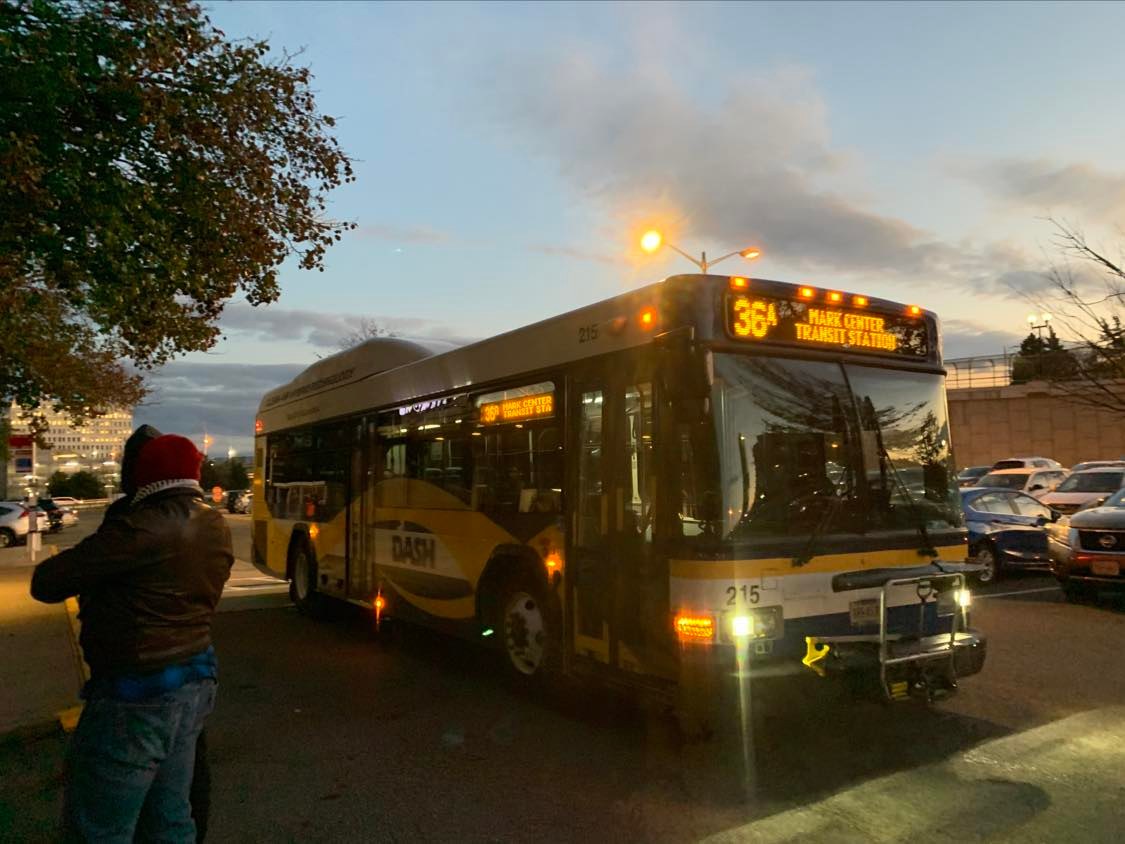
While the plan is to eventually create a new transit hub in the Landmark Mall redevelopment, the city is looking for grant funding to make the key transfer point more bearable in the near term.
The Transportation Commission is scheduled to vote on Wednesday, Oct. 18, to endorse a grant application to the Department of Rail and Public Transportation for up to $544,000.
A memo from Transportation and Environmental Service Deputy Director Hillary Orr said the hope is for funding to make improvements ahead of the new transit center, which isn’t scheduled to open until 2028.
“The City requests authority to apply for the new category of Passenger Amenities to provide shelters, benches, and real-time signage at the planned transit center in the West End development until a permanent structure is built,” Orr wrote. “Currently, this is a high ridership location and key transfer point with more than 500 boardings per day.”
Orr said the city was awarded $13 million in funding for the new transit center, but that construction funding won’t be available until FY26. While the full transit center won’t open until at least 2028, Orr noted that bus operations could begin using the area as a transfer point sometime in 2024.
“This funding would allow for proper amenities at a major transfer facility serving multiple local bus routes and two future bus rapid transit corridors until a permanent structure is constructed,” Orr wrote.
The temporary improvements would include 12 bus shelters and real-time signage. Once the transit hub is completed, the city said the temporary bus shelters can be relocated.
The total project cost is estimated at $800,000, with the City matching funding up to $256,000 if the grant is approved.

Alexandria’s DASH bus network ridership is growing faster than bus networks in Arlington and Fairfax, though not as quickly as local rail ridership.
A report to the Northern Virginia Transportation Commission showed that DASH had a 17% increase in ridership from August 2022 to August 2023.
The total ridership in August 2023 was 1.3 million, nearly double the ART bus ridership and slightly more than half that of the Fairfax Connector. ART bus ridership grew 11% over the last year, while the Fairfax Connector’s ridership grew 15%.
Still, that doesn’t hold a candle to regional ridership of the Metro, which had a 36% ridership growth in the last year to a total of 7.7 million riders on the Virginia lines this past August.
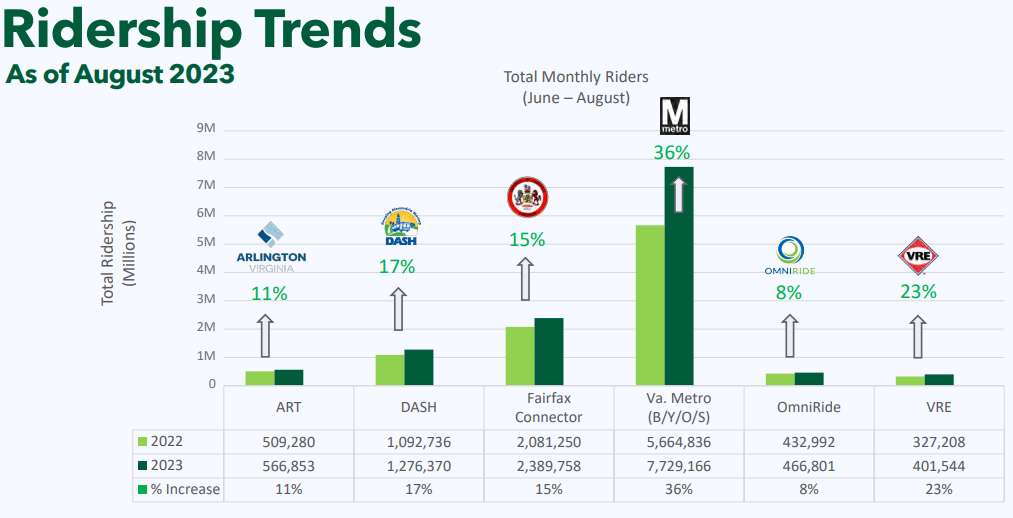
It’s been a banner year in ridership for Alexandria’s DASH bus network. The bus network celebrated record high ridership earlier this year, fueled by a mix of realigning the system to prioritize more frequent service in higher-density corridors and going fully fare-free — though whether that change is permanent is unclear, given the long-term challenge offsetting the lost income presents.
Alexandria parents are up in arms over a staffing crisis within Alexandria City Public Schools.
Kelly Organek says that her ninth-grade son at Alexandria City High School’s Minnie Howard campus hasn’t had a geometry teacher since school started in August and that he only recently got a new biology teacher.
“We are in a staffing crisis that is not okay for our children,” Organek testified to the School Board last Thursday night (Oct 5). “Since August 21, my son has had to teach himself biology and geometry. We have no way to know if he’s learning the material.”
ACPS staff also provided an update on staffing woes. The school system currently has 55 central office vacancies, as well as more than 100 licensed and non-licensed school-based positions. Just how many teachers are needed is not clear, and ALXnow is awaiting a more comprehensive breakdown of ACPS staffing needs.
“We’re at a point now where people are just looking for bodies to put in classrooms and that makes me so sad,” said Board Member Meagan Alderton. “I think the people on the ground, the HR (human resources) folks, have got to do the work.”
The ACPS employment page lists dozens of vacant positions, including high school science, math and history teacher jobs.
“We do know that the last couple of years have been very challenging for all of our staff,” Superintendent Melanie Kay-Wyatt said.
Margaret Browne, the ACPS director of recruitment and retention, said she is working on streamlining the onboarding process so that applicants can start work faster. She also said that ACPS advertised positions on radio stations, television, newspapers and online media, and that she and her staff conducted 13 job fairs in-house and traveled to 40 career fairs around the country last school year, including to Puerto Rico.
“I anticipated that we were going to do a large number of events last year and I’m ready to set a new record (for job fairs),” Browne said. “We’ll go down the Eastern Seaboard. This time we are going west and we’ll also do Puerto Rico again.”
The school system is also short 15 bus drivers and is offering an additional 5% raise for drivers over the course of the next three years.
Browne said that ACPS will also focus on marketing to people switching careers within associations and military organizations.
David Paladin Fernandez has been an ACPS 6th and 8th grade general education teacher for eight years. He said that his salary has been frozen half that time, and that due to an impasse over collective bargaining that the school system is running short on special education teachers, bus drivers, paraprofessionals, guidance counselors, therapists, audiologists and more positions.
He also brought a red velvet cake to the School Board meeting.
“Our district is facing a staffing crisis like we’ve never seen, and our management would rather spin stories than face the reality that their recruiting and retention efforts are simply not enough,” Fernandez said. “School Board members, tonight you have heard and will hear from a number of Alexandria citizens who have been personally impacted by the decisions ACPS management has made under your watch. These citizens come to you asking, nay demanding that you start holding management accountable because the things that they are saying to the public do not match the actions we see. It’s as ridiculous as offering cake at a School Board meeting.”
Rene Pascal, the acting head of human resources for ACPS, said that teachers should feel incentivized to work for ACPS by paying smaller premiums on their health plans (see graph in above gallery).
Alexandria City High School parent Sarah Schultz said that ACPS is not being transparent on staffing woes.
“We’re asking our children to receive instruction without teachers,” ACPS parent Sarah Schultz told the Board. “We feel strongly that ACPS should not take the stance that online classes are a reasonable substitute for in-person instruction, especially for required courses and question the equity of moving groups of students to online while the rest of the students receive in-person instruction.”
Two ACPS recruitment videos made earlier this year are below.

Arlington calls for aid, and Alexandria will answer.
Alexandria’s City Council is scheduled to vote at a meeting on Tuesday, Sept. 26, to support neighboring Arlington’s funding application for an expanded Shirlington Transit Center.
Arlington County is applying for funding from the Northern Virginia Transportation Authority to expand the transit center in Shirlington, a major hub for bus traffic.
“Arlington County has requested $11.6 million to fund the Shirlington Bus Station Expansion,” Director of Transportation and Environmental Services Adriana Castaneda wrote in a memo. “This station is the principal transfer point for Arlington Transit (ART) bus service, Washington Area Metropolitan Transit Authority (WMATA) Metrobus service, and bus service (Routes 36A and 36B) in South Arlington.”
While the project is outside of Alexandria, Castaneda said Alexandria would benefit from the project as some of those added bus bays would serve the West End Transitway, which will stop at the Shirlington Bus Station.
“This capital project focuses on adding bus bays at the Shirlington Bus Station to meet future demand, including the space needed for future West End Transitway buses and any service improvements from Alexandria’s Transit Vision Plan, as well as expansion plans of Arlington Transit and WMATA,” Castaneda wrote.
The West End Transitway is a project that will connect transit facilities along the West End, from the Van Dorn Metro station up to Shirlington, passing through the redeveloped Landmark Mall site. The project is in the design phase, with construction scheduled for 2025-2026, opening sometime in late 2026.
Image via Google Maps
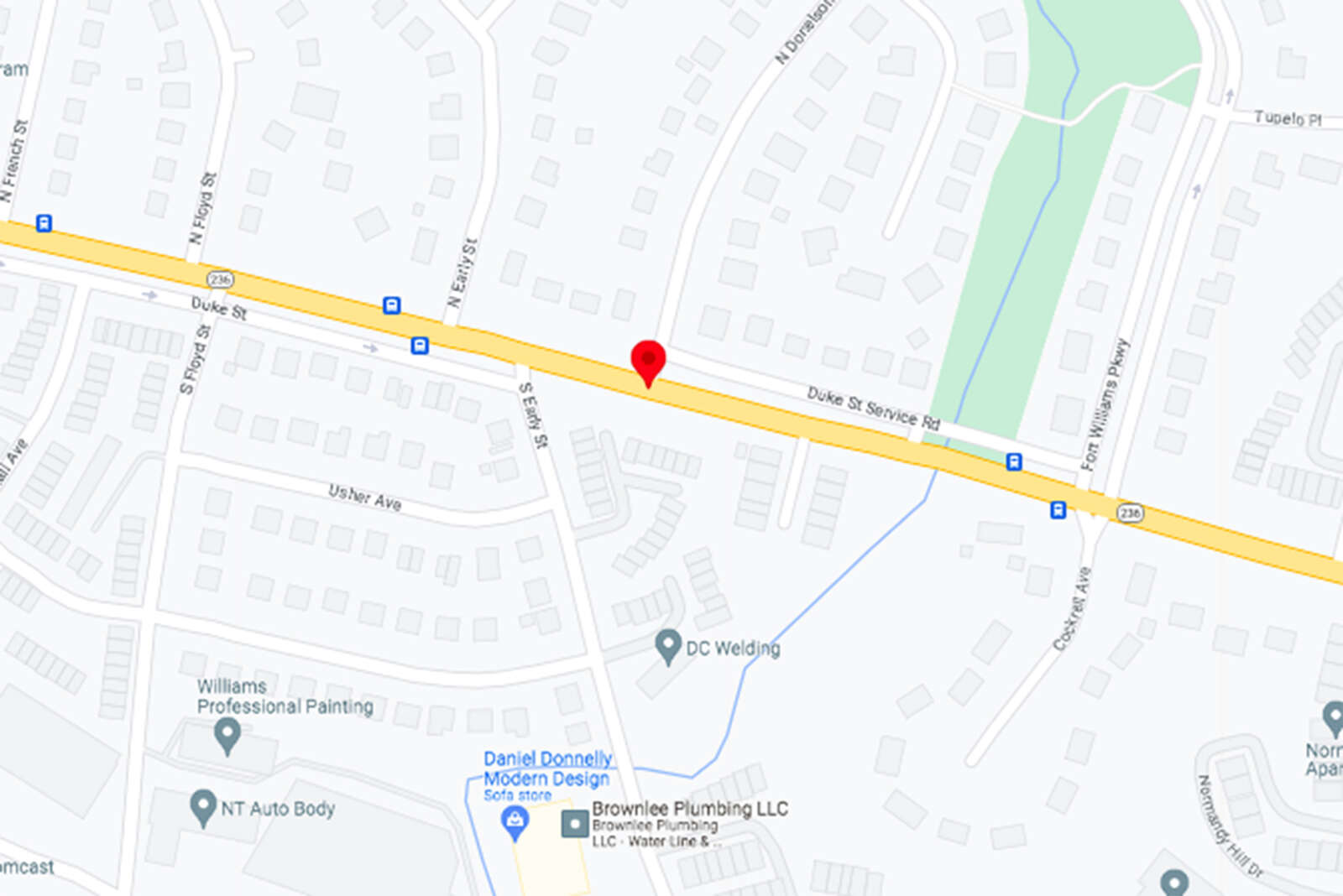
Four Alexandria teenagers were robbed by six masked suspects on Monday (July 31) at a bus stop in the West End, according to police.
The juvenile victims, all 16 years of age, were not injured in the incident. At around 9:15 p.m., the victims were waiting at a bus stop near the intersection of Duke Street and N. Donelson Street when the suspects pulled up in a black Toyota Corolla.
The victims told police that four men and two women wearing ski masks got out of the car and then stole money and personal items. No one was injured and no weapons were used by the suspects, according to police.
A father of one of the victims reported the incident on NextDoor.
Anyone with information on this incident can call the Alexandria Police Department non-emergency number at 703-746-4444. Callers can remain anonymous.
Image via Google Maps

